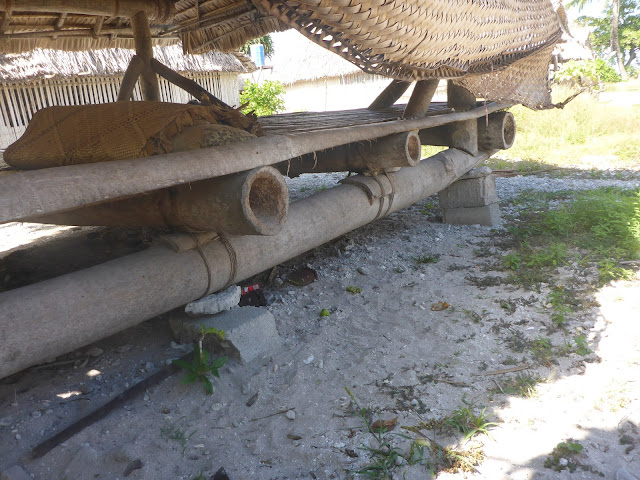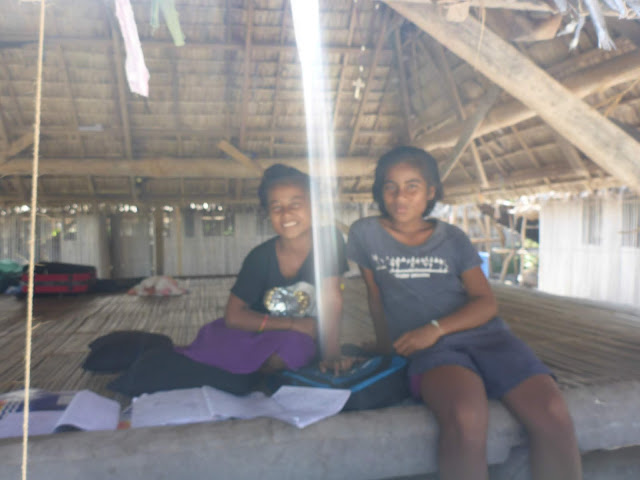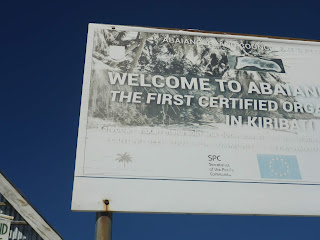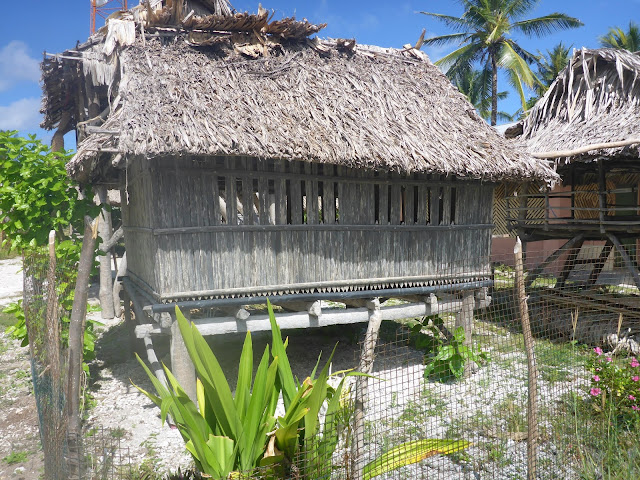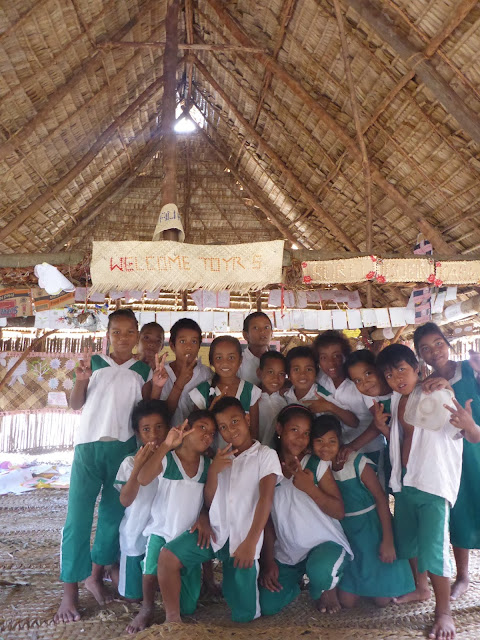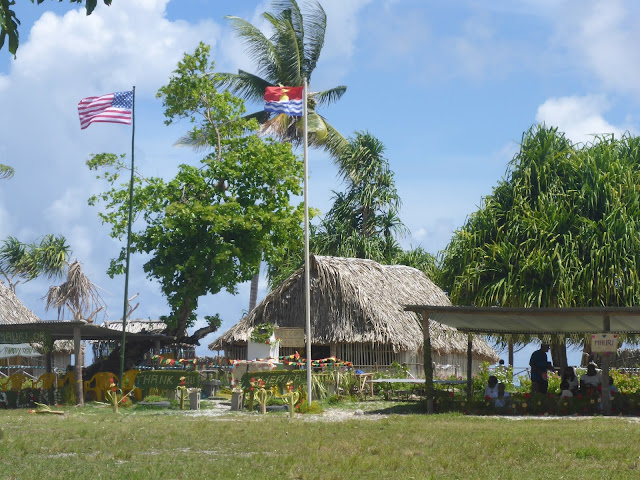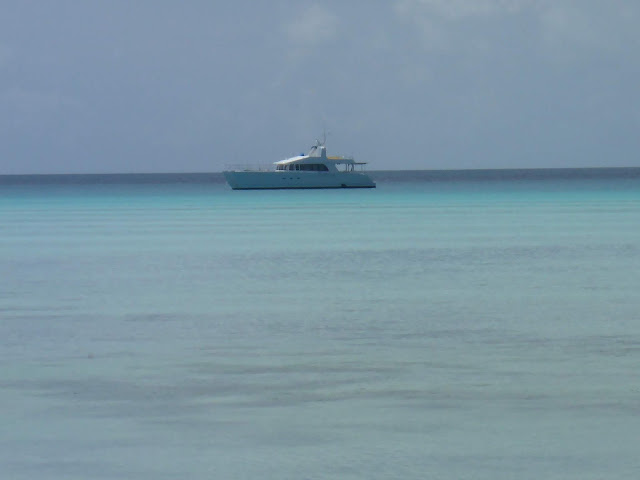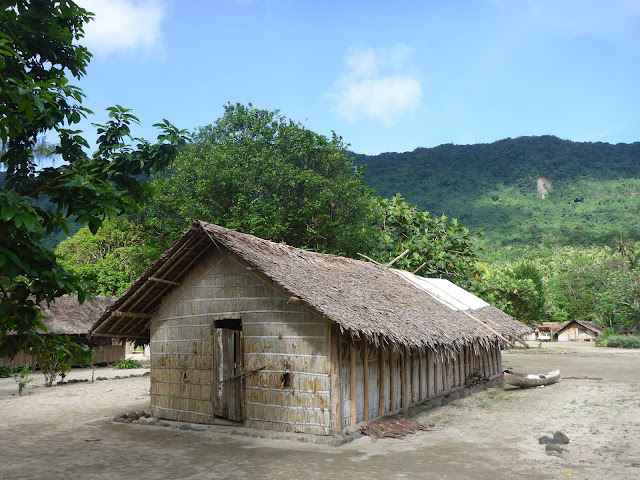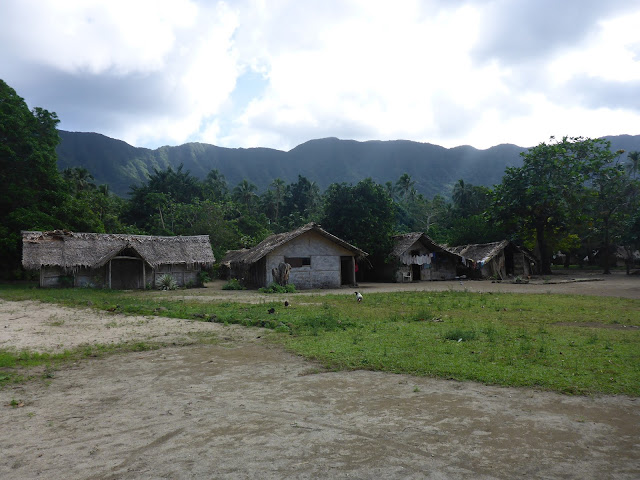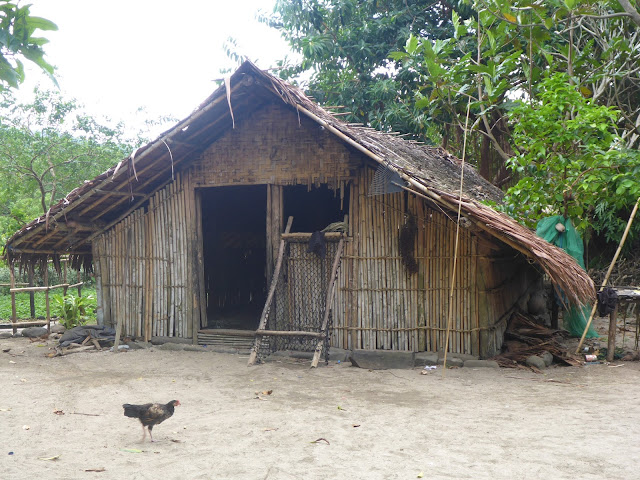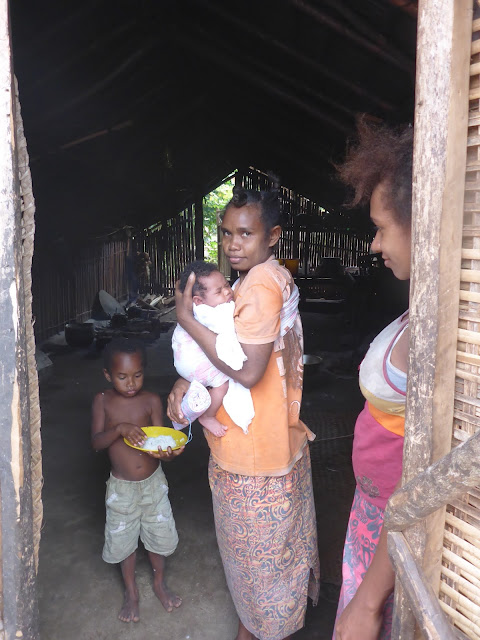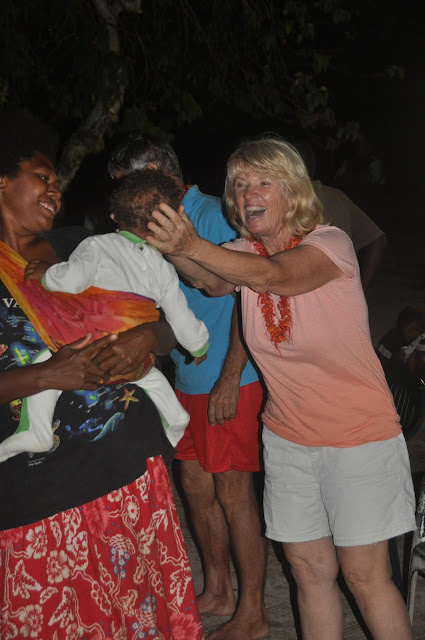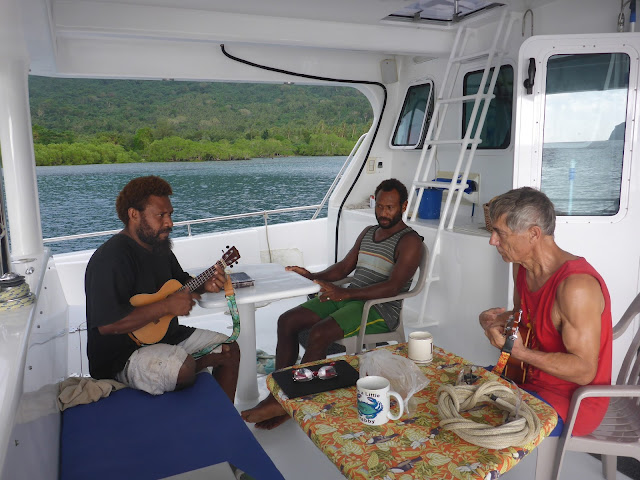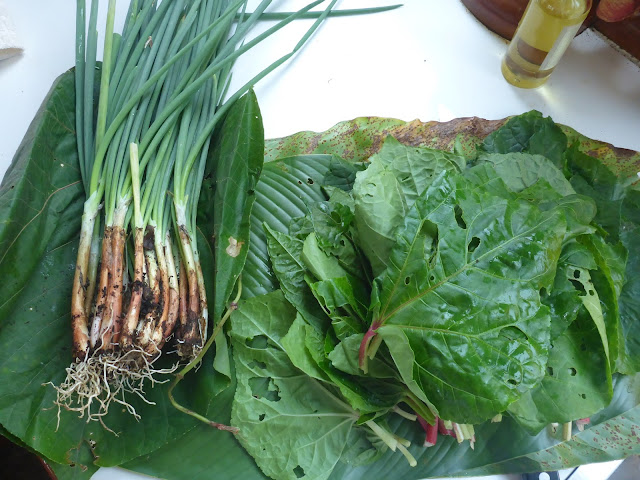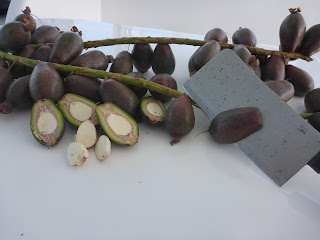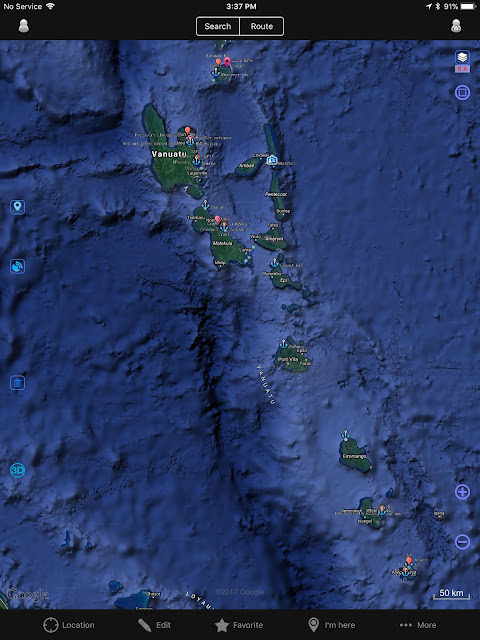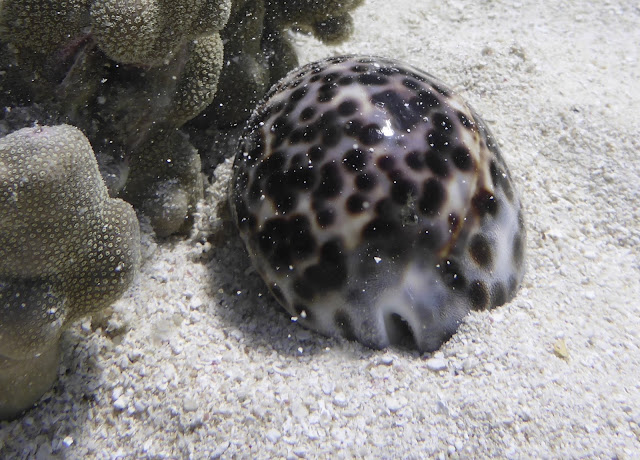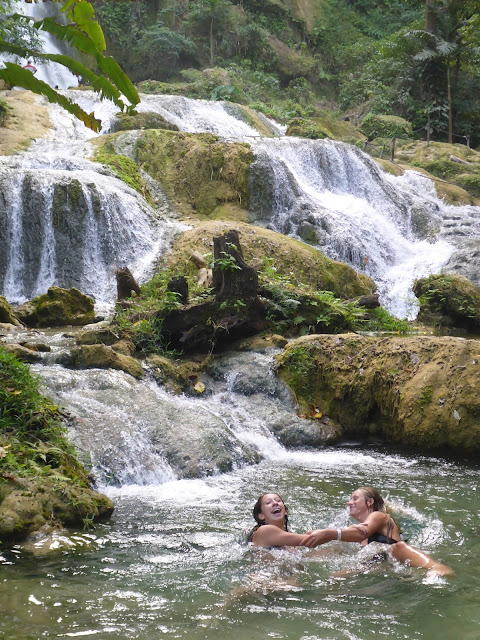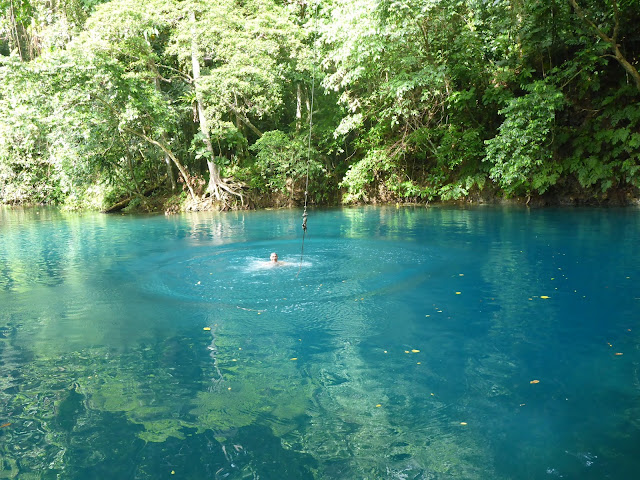TRANSPAC 2
Week 1
Marshall Islands to Midway
June 4-11, 2018
* I hope you enjoy the recipes and book references.
June 7, 2018, some 750 NM north-northeast of the Marshall Islands.
When I think of crossing oceans on board a power yacht, I want a good captain, one who can fix anything in DOMINO’s twin engine rooms. Automatically, my mind flashes back to Robert Mitchum (or was that Kirk Douglass? or Bogie? My memory fails me…) peeking out of his stinkpot’s engine room, on a Carribaen-blue background, captain’s cap askew, a crooked smile across his face, nonchalantly wiping his grimy hands on an oily rag (Name that movie?)- Well, I don’t have a movie star on board, but I have my captain JP who, if not as nonchalant as the heartthrob Mitchum, is at least as handsome in my eyes, and a true mechanic. In this second transpacific crossing, from Majuro (Marshall Islands) to Sitka (Alaska), a 4,000 NM endeavor, once more I place my life in JP’s very capable hands.
 |
| Leaving the Marshalls (bottom left of the screen: all calm) |
Day One – June 4, 2018 – For the last ten days, we have kept an eye on the weather. We had provisioned early, not because we expected an early departure, but because the produce cargo ship had just arrived in town, and in Majuro you buy the produce when it’s on the shelf! From the GRIB data, we were expecting to get underway on June 8. But, last night’s data turned our plans upside down: a 3-day window had opened, with almost no wind in the dreaded trade wind belt north of Majuro. Just like that, we had to go! I just had time to prepare and freeze some cauliflower au gratin and vegetable lasagna.
CAULIFLOWER AU GRATIN –
- 2 heads of cauliflower, steamed
- 2 cups Bèchamel Sauce
- 1 cup grated Swiss cheese
- 3 hard boiled eggs, halved lengthwise
In an oven-safe dish, place the steamed cauliflower florets.
Mix the still-hot Bechamel sauce with the grated Swiss cheese to make a Mornay Sauce. Pour on top of Cauliflower and eggs. Bake for 20 minutes, let cool, vacuum-bag lightly and freeze.
 |
| The beefy commercial bunkering dock in Majuro. |
9 AM local time- We are at the fuel dock in Majuro, bunkering 2,500 Gallons on top of the 420 gallons left in our day tanks. The fuel is sampled, tested, and not a drop of water found. This load should take us all the way through our 4,000 NM crossing, at 10 Kts, in average sea conditions. By 1300 (0100 UTC), after the obligatory rounds of Port Captain, Customs, and immigration, we slip our dock lines and off we go! The weather GRIBS were right. Instead of the typical 20-25 Kts trade winds and 2m beam seas, we encountered no wind over 15 kts and no seas above 1 meter, except for a few squalls during the night, 30 knots and buckets of rain, a bit of a roll, but short-lived.
 |
| Our planned rhumb line… but Moana had another plan for us! |
Day 2 – June 5 – You gotta love it when the GRIBS over-estimate the wind! We are finding nothing above 10 Kts and a gentle, 1-m long swell. But why is the sun not showing? We can’t even identify a definite cloud cover. The haze drifting from the Hawaiian volcano to the North-East is enveloping us in an eerie, cottony bubble. Engine checks: all is good, but perhaps a few drops of something under the starboard engine show up on the late evening check, nothing much. Time to bake bread!
DOMINO’s Multigrain Bread – In the breadmaker (I use a BREVILLE) pour:
- 2 1/4c water
- 2 1/4 tsp salt
- 1 Tbsp brown sugar
- 4 cups unbleached bread flour
- 1 cup organic whole wheat flour
- 3 Tbsp powdered milk
- 1/2 Tbsp organic gluten flour (gives added structure to the bread)
- 1 1/4 Tbsp yeast
Set the bread maker for basic bread, large loaf, dark crust.
In the seeds dispenser, add the grains:
- 1/4 cup oats
- 1 Tbsp sesame seeds (white or black)
- 2 Tbsp sunflower seeds
- 1 Tbsp Chia seeds
3 1/2 hour later, voila!
Day 3 – June 6 – 0100 UTC – Engine check: OOPS! Coolant, a lot of coolant is leaking under the Starboard (STB) engine, something like a half-a-gallon in the bilge… not good! What possibly could be leaking? JP’s brain revs up, now in high gear. On thorough inspection, he finds a lone nut lying in the bilge. EUREKA! Must come from the turbo. Sure enough, one the four nuts holding the turbo is missing, the stud broken, the bolt shorn off. This has to be fixed immediately. We are at risk of the turbo completely breaking off, hot, dry exhaust gas coming out and setting the boat on fire. “Not good,” says JP, biting his lower lip. “Gonna be a bitch to fix! Dunno if I can do it. Gonna need to help me. Gonna be hard to do!”
In times of crisis like this, the 1st Mate’s job is to get quiet, trust the captain 100%, let him think, and think hard, and be efficient. But JP and I have worked together for over 40 years, and when the proverbial shit hits the fan, we go into our team mode. First, turn off the STB engine and keep going on the PORT engine at 900 rpm, still making 7.4 kts, not losing too much headway. While the STB engine cools off, I periodically irrigate the STB Sureseal to avoid overheating and melting that could be caused by the still-turning shaft (probably not necessary but the last thing we want on this crossing is a melted-down Sureseal!)
JP gathers tools, parts, and his wits… just like the old days in the Emergency Clinic! The plan? Remove the turbo, extract the shorn-off studs, and put everything back in place. Fortunately, the wind has decreased to 6 knots and the swell is now below 1 meter, a very long and smooth Pacific swell. Thank you, MOANA!
 |
| The culprit: shorn-off bolt #1 |
And thus it goes: drain all the coolant, remove the air intake casing, the stainless steel dry exhaust tube, disconnect all hoses to the turbo, and find out that not ONE, but TWO bolts have shorn off. OK, so remove the last 2 bolts standing and take the turbo out. Easy-Peasy. Now the hard part: removing the shorn-off studs. The 1st one hads a little stub coming out and is removed fairly easily, but not so for the second one, shorn-off flush with the exhaust manifold. Simple solution: drill a small hole in the center of the stud, insert an extractor screw, and counter-screw the little bugger out of its place. No dice! It’s frozen. Desperate times ask for desperate measures: Propane torch time! A few drops of penetrating oil, a bit of heat to the area, and BINGO! Out pops the reluctant stud.
 |
| Always a good idea to have an extractor set on board. Got the broken bolt! |
From here on, it’s all back-tracking, taking advantage of the situation to replace the exhaust manifold-to-turbo gasket. All done? Check for extra parts left on deck? None? That’s good. Fill up with coolant, settle it, top it off… restart the engine, check for leaks, shift into forward, check for leaks, throttle up, check for leaks, all good.
It took JP just over 5 hours to fix this potentially devastating situation. But here he was, sweaty, grimy, and a grin on his face, “No leaks!” Yeah, I like my captain, the fact that he had planned for this eventuality by stocking on parts and tools: gaskets, bolts, studs, coolant, empty drums and cans, drill bits, extractor set, propane torch, even a new lighter!
After a refreshing shower, JP had earned his favorite dinner: “Timbale aux Coquillettes” (that’s French for Mac-and Swiss-cheese-and-ham casserole, sans les champignons.)
In the morning, not a drop of coolant in the bilge! Time for a second treat for the Captain: banana bread… oh, did I forget to mention? We had a bunch of bananas on board!
Timbale aux Coquillettes (for 2)
- 4 Cups cooked macaroni, still hot, salt and pepper
- 2 Cups grated Swiss Cheese
- 1 1/2 Cup chopped ham
- 1 1/2 Cup sautéed mushrooms
Mix the macaroni, ham, mushrooms and half the cheese. Fill an oven-proof dish with the mixture. Sprinkle the rest of the cheese on top. Bake at 350F for 20 minutes, switch to broiler and broil till the top is golden. Eat half, freeze half.
 |
| A perfect day… (we are the white dot) |
Day 4 – June 7 – What a perfect day! Yesterday’s repair of the turbo is holding, no leak, and the weather is as calm as one could wish for — gentle seas and 5 to 10 Kt. wind, and even if it’s on the nose, it remains quite pleasant. Domino unleashes her long stride, running an easy 10 Kts. at 1180 rpm, burning 6 GPH, a bit hungrier than normal, but expected in head seas, contrary currents, and a full belly. We lucked out on the weather window, really, since the area we just covered in the last 48 hours is now buffeted by 20-25 Kt. trade winds. At last, in the afternoon, the winds shift to the SE, giving us a push, and we are now running at 10.8 Kts. at 1100 rpm, 5 GPH… yes, that’s more like it.
But a Transpac wouldn’t be right without a bit of drama. Suddenly, a massive squall line appears on the radar, 16 NM in diameter, impossible to avoid, so we brace for it. For an hour, we are buffeted by sustained 30-kt winds, gusting at 44 Kts, the mild seas growing into 2-3m head seas, pounding rain and tons of foamy water breaking on deck, strong enough to bend one of our windshield wiper blade… well, that’s a first! After a 30-mn relative lull, another squall pounds on us, only in the 28-kt range and shorter-lived. Once more, we brace and let DOMINO perform her usual samba through the pounding seas. Once more, we are amazed at this awesome powercat’s stability, its ability to rise above the crests and not slam into the troughs, the smoothness of the ride, and we have gotten used to her trademark “samba” sway. Never do we experience the bone-shuddering slamming that we have witnessed or heard of on so many other catamarans, sail or motor. Once more, we silently thank Malcolm Tennant and Anthony Stanton for their CS hull design and strong, commercial-grade structure.
After 3 hours, at last, the wind abates, the rain stops, and the seas gradually recede. Thankfully, all that rain has scrubbed the air from the volcanic ash and gasses, and we can sea the sun again. This was the strongest gale we’d ever experienced, but we had learned to trust our boat and felt absolutely confident that DOMINO would strut her stuff when needed, and she didn’t disappoint.
At last, the sun returned, the wind shifted to the SE and gave us a push once more as we carried on at 11 kts on 5 GPH, 1100 rpm. Lunch, though, was a small affair, a half a turkey sandwich with a handful of baby carrots… and a slice of banana bread!
Day 4 – 248 NM made good
Cream-Cheese and Honey Turkey Sandwich
Slather cream cheese on both slices. Arrange basil leaves on the cheese, add a twist of ground pepper. Place turkey on one side, close the sandwich, slice in half. Serve with slices of green apple.
 |
| On quiet crossings, JP loves to tinker with boat design. |
Day 5 – June 8 – We love it when there is absolutely nothing to report, but sun, calm seas, gentle wind on our STB quarter, and making 11 kts on 5 GPH. JP throws a trolling line in the water as a flock of red-tailed Phaetons materializes on our stern. Meanwhile I attend to a bit of laundry, bake bread, and we decide to bake macaroons together. If the bananas are now gone, we need to get rid of the coconuts: let’s go grate some coconuts!
Coconut Macaroons
Mix all ingredients together. With your hands, fashion small cones and place on cookie sheet lined with wax paper. Bake at 350 for 15 min. Open the oven door and let dry in the oven 5 minutes more. Transfer to cooling rack.
Day 6 – June 9 – Three things happened today:
1- We crossed the date line – 180 degrees of longitude. In the middle of the night, we went from 179*59 East to 179*59 West and 180* was just a bur. A stealth move! No longer are we a day ahead of our US and French families. No longer will we be the first to post “Happy Birthday” on their Facebook pages. No more 2-day celebrations, which really was fun on Christmas, New Years and birthdays. We are back into the fold, a small step towards coming back to the norm. I’m not sure what I feel about that; a small sense of loss, perhaps?
2- We completed 1/3 of our crossing – Since we’d left I had been nervous about our fuel burn. Oh, sure, we had our historical data, our trip fuel burn expectation, had loaded an estimated 400 gallons extra fuel, but I was still nervous about the reality of this crossing. Well, no need to fret. We have consumed 800 gallons to cover 1300 NM at an average of 10 knots, or 0.6 gallons per mile. Sure, it’s a bit more than our usual 0.5 GPM, but we have been riding into head seas, against currents, on a full belly of fuel and water, and against a few gales. Yet, with 2,700 NM left to go and at that rate, we would only need 1,620 gallons. We have 2,100 gallons left, an almost-500 gallons overage, allowing us to speed up if needed (we can go up to 20 kts) to run away from a front, slow down and divert if we need to wait for a front to pass, or even completely divert to a new location if the weather sours. Five hundred gallons, or nearly one thousand miles of safety options. I’m feeling better.
The weather has been absolutely perfect, no wind, slight swell on our starboard quarter, and now the wind has turned to the SSW, only 6 knots, but we expect to see less of a current against us, improving our performance. At this moment we are traveling at 11.4 kts, 1114 rpm, 5.2 GPH.
3 – We caught fish! A nice, meaty wahoo, another Red Eye Lure catch… just like that, we have 7 kg (15 lbs) of filleted wahoo in the fridge, looking forward to more recipes!
Perfect time to cook a nice meal: Wahoo on a bed of gingered leeks.
Wahoo with gingered leeks
Blanch the leeks by dumping them in boiling water for 3 minutes. Drain and set aside.
In a large skillet, melt the butter, add the ginger and heat up till it smells good. Add the sliced onion and sauté until translucent. Add the leeks, stir, and simmer – partially covered— for 15 minutes or until leeks are tender. Salt and pepper to taste.
Place the fillet of wahoo on top of the leeks, cover, reduce heat and steam until fish is barely cooked. Remove from heat, transfer to serving platter. Season with salt and pepper to taste, a pad of butter on top of the fish.
= Serve with steamed Chinese rice with organic wakame seaweed.
 |
| 2 nice fillets! |
Day 7 – June 10 – Another perfect day, sunny, no wind, flat seas, and a whale sighted use to our port side. We reached the NW end of Midway Atoll National Reserve, under the control of fish and game, and took our heading towards Sitka, Alaska, using the Great Circle Route, as generated by our on-board Navnet system. But before committing to this heading, we took a look at the weather, downloaded from PredictWind via Iridium on our iPad, and were in for a shock.
 |
Uh-oh… We are the bottom-left white dot, on our way to the green marker…
Let’s keep an eye on this baby |
Two large storms are forming NW of us. If we can dodge the first storm, there is serious doubt as how to dodge the second storm which looks very powerful already. So, we remain on the straight course, a bit south of the rhumb line, waiting for the next weather report. From our current position, the rhumb line affords a distance saving of 121 NM, not worth committing to it if we need to turn away from it later, so we remain on a straight course. In the morning, the weather report is daunting. This large storm is headed straight into our intended path and our NE route is now unthinkable. There is nothing better for us to do but alter course to the ESE, remain below the 31st parallel, and keep an eye on the weather. The storm is supposed to dip very low, possibly south of the 30th parallel. This means also that we must drop out speed, not only to let the storm pass us, but also to save fuel. This new course means an extra 500 NM, or about 250 gallons of fuel, which is well within our 500-gallon security margin.
 |
We are at the green spot… this storm is picking up steam.
Plan is to duck southeast till the storm passes. |
There is nothing wrong with steaming at 7.5 knots on one engine, 900 rpm, burning barely 2 GPH. We are in no rush to get to Alaska. In fact, I thoroughly enjoy these warm, tropical days, traveling on flat seas and preparing meals for a stormy day!
 |
| Duck south! Way South! |
Lunch is a refreshing affair of marinated wahoo and gingered cabbage salad.
Marinated Wahoo
In an air-tight container or large glass jar, place the sliced wahoo, onion, carrot, garlic, herbs and spices, cover with olive oil. Mix well. Add lime juice, mix and close the container. Keep refrigerated, serve cold. Will keep 5-7 days in the refrigerator.
 |
| Quick easy lunch! Marinated wahoo. |
BOOKS READ:
- Origin (Dan Brown) 5 stars
- The Black Book (James Patterson) 4 stars
- The Fallen (David Baldacci) 4 stars
- Red Sparrow (Jason Matthews) 5 stars
- Palace of Treason (Jason Matthews) 4 stars
- The Kremlin Candidate (Jason Matthews) 3 stars
- At the Edge of the Orchard (Tracy Chevalier) 5 stars
till next blog
dominomarie



















